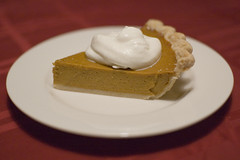 Good Morning! Is your fridge stuffed with leftover food from Thanksgiving like mine is? In the past, we would eat some of it, but usually about two weeks from now, I'd be throwing a bit of it away. This year, I'm determined not to let that happen. I've talked about food waste before. In the U.S., we waste about 30% of the food produced in this country. If you consider all of the resources that went into making the food and all the energy that went into transporting that food, that is a heck of a lot of waste.
Good Morning! Is your fridge stuffed with leftover food from Thanksgiving like mine is? In the past, we would eat some of it, but usually about two weeks from now, I'd be throwing a bit of it away. This year, I'm determined not to let that happen. I've talked about food waste before. In the U.S., we waste about 30% of the food produced in this country. If you consider all of the resources that went into making the food and all the energy that went into transporting that food, that is a heck of a lot of waste. So I'm going to make sure that I use up the leftovers. I'll be making turkey, stuffing and cranberry sandwiches, turkey soup, potato pancakes, and my turkey pot pie. This recipe originally called to be done traditionally in pie crusts (which I still do on occasion) but an easier, very tasty way to do it is to make the filling and then ladle it over biscuits.
Turkey Pot Pie over Biscuits
Ingredients
1. Melt butter in large saucepan
2. Stir in flour, salt, marjoram and pepper - cook until smooth, stirring occassionally
3. Slowly stir in milk, then water
4. Add bullion
5. Bring to boil, reduce heat and stir constantly until it thickens
6. Add turkey and vegetables, cook for 20 minutes - make sure turkey and veg are cooked through
7. Serve over homemade or store bought split biscuits
Ingredients
- 6 tbsp. butter
- 1/3 cup flour
- 1/2 tsp salt
- 1/4 tsp dried marjoram
- 1/8 tsp black pepper
- 1 cup milk (I use 1% and it works fine)
- 10 oz. hot water
- 1 tsp. chicken bullion
- 3 cups cubed turkey
- 16 oz. partially cooked mixed vegetables
- biscuits
1. Melt butter in large saucepan
2. Stir in flour, salt, marjoram and pepper - cook until smooth, stirring occassionally
3. Slowly stir in milk, then water
4. Add bullion
5. Bring to boil, reduce heat and stir constantly until it thickens
6. Add turkey and vegetables, cook for 20 minutes - make sure turkey and veg are cooked through
7. Serve over homemade or store bought split biscuits
I challenge you to get creative and figure out how to use up all your leftovers yesterday. Don't let any of them go to waste. Give them away if you need to.
And the picture above really has nothing to do with this particular post. It's just my cat, sitting at the table last night, waiting for dinner to start. She seemed rather surprised when my husband pushed her off the chair and sat there himself.

















